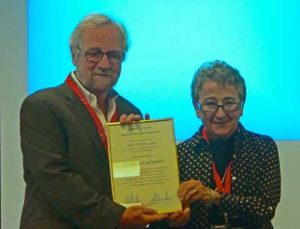The 2015 ISDDE Prize
for Lifetime Achievement in Educational Design
Solomon Garfunkel: Director of COMAP

The International Society for Design and Development in Education (ISDDE) has awarded the prestigious 2015 ISDDE Prize for Lifetime Achievement in Educational Design worth $10,000 to Solomon Garfunkel, Director of the Consortium for Mathematics and Its Applications (COMAP) in Bedford, Massachusetts.

“This award recognizes the excellence of the design and development work in mathematics education that Sol Garfunkel and his team have produced over many decades,” said Professor Susan McKenney, Chair of ISDDE.
“Through a series of ground-breaking initiatives Sol and his team have succeeded in moving the teaching and learning of mathematics in high schools and undergraduate programs forward in important ways” she added.
The unifying theme in Garfunkel’s work has been the teaching of mathematics through mathematical modeling of real world situations – the message has always been that math is important, useful and interesting and the COMAP designed resources reflect that philosophy.
About COMAP
Since its inception in 1980, COMAP has developed a library of mathematical applications and championed the development and use of modeling to show students the applicability of mathematics in solving the world’s problems. COMAP supports the teaching of mathematics by:
- using a multidisciplinary approach where students use mathematical modeling and technology to investigate important issues in their lives;
- creating materials to broaden students’ appreciation for mathematics both as an evolving science and as a powerful tool to explore our world;
- issuing research reports aimed at strengthening teacher preparation in mathematics at all levels; and
- promoting collaboration between the educational community and practitioners of mathematics globally
Some key examples of COMAP’s output are outlined in Appendix 1; for more details about COMAP and its work visit http://www.comap.com.
Contacts
- Prize winner – Sol Garfunkel (Director COMAP; )
- ISDDE – Susan McKenney (Chair; ) OR Will Morony (Communications; )
COMAP website
Download short press release as PDF
Download full press release as PDF
Download press release as DOCX
APPENDIX 1 – Highlights from COMAP’s initiatives:
Community: From the beginning, Sol’s vision has been of COMAP as a community, which needs support. The UMAP Journal, beginning in the early 80’s, was unique: a peer reviewed academic journal that contained student material (the UMAP modules) designed for in-class use, along with articles on the teaching and learning of modeling and applications. Consortium, though primarily a public information newsletter, is rich in content, with articles addressing careers, contemporary applications, historical notes, and a pull–out section which is essentially a lesson plan. In addition to the content, a great deal of effort was spent on the ‘look’ of the journals with a significant art program. The samples website illustrates all of these with:
- an issue of Consortium, along with an outline of its design structure
- an issue of UMAP Journal, similarly described
- some samples of the Cover Art
It is also worth noting that the COMAP modeling competitions at undergraduate and high school levels have extended the reach of the COMAP philosophy worldwide. Last year almost 10,000 undergraduate teams, many from China, competed, advancing modeling work in the U.S. and abroad.
Television series: The telecourse For All Practical Purposes consisted of 26 half-hour episodes, hosted by Sol Garfunkel who led their design. It aired on PBS and won several national and international awards. The associated text was widely used for Mathematics for Liberal Arts courses, changing that important market. It was followed by two additional telecourses – Against All Odds: Inside Statistics and In Simplest Terms, which Sol also hosted.
Memorable individual classroom units: There are many units that, individually, fulfill the prize criteria of design excellence, enhanced by surprise and delight. Voting systems and the five candidates from the Replacement Party (Impossibility Theorems), the scheduling problem for the nightly news, and the non-zero sum games of chicken – these are outstanding examples.
Projects
COMAP has been dependent on project funding from funders who recognize the value of the work in advancing mathematics education. Over the past 35 years there have been too many projects and products to describe here.
Here are brief outlines of some of the most important, and prize-worthy:
- The Undergraduate Mathematics and it Applications Project (UMAP) – Funded by NSF from 1976–1984.The UMAP project was designed to create lesson length undergraduate modules that taught mathematics through real and contemporary applications. It gave rise to the UMAP Journal now in its 36th year, which continues to publish student ready material and articles about the teaching of modeling and applications on a self-sustaining basis.
- The High School Mathematics and its Applications Project (HiMap) – Funded by NSF, HiMap was designed to produce student and teacher applications material at the secondary level. Modules were designed for one week of classroom work. Many of the modules focused on discrete models such as graph theory and game theory, which most high school teachers were seeing for the first time.
- The Mathematical Contest in Modeling (MCM) – Funded by the Fund for the Improvement of Post-Secondary Education (FIPSE), 1984–1987. MCM is a true team competition, held over a four-day weekend, in which teams of up to three undergraduates may use any and all inanimate resources to work on an open ended modeling problem. In its first year of operation there were 90 competing teams from 70 U.S. colleges. In 2015, there were over 9500 teams from 20 countries participating. As with UMAP, after the initial external support we have been able to continue and expand the effort on a self-sustaining basis.
- Application Reform in Secondary Education (ARISE) – Funded by NSF, 1992–1998. ARISE was the largest COMAP project by far. It was a comprehensive development project to design a full four-year high school mathematics curriculum. We involved a team of our 40 writers who were either high school or college teachers and included the guidance of Henry Pollak. This was a curriculum intended to make the NCTM standards extant. It was designed to teach mathematics through context. The assessments were designed by a team from the Freudenthal Institute, led by Jan de Lange. The materials were field tested at over 20 high schools and revised according to teacher feedback. The texts were made available beginning in 1997; they have recently been revised and are still in use.
- Principles and Practice of Mathematics – Funded by NSF, 1994–1997. Nicknamed Math 101–102, this project produced a full one year introductory undergraduate mathematics offering for STEM majors. The idea was a simple one, but profoundly controversial. The thought was that, if as an undergraduate you took Physics 101–102 or Chemistry or Biology, at the end of that year you should have a good idea of what physicists or chemists or biologists do. You would have a survey of the field, so that if that were your last science course, you would have some general understanding of the subject; if you were to go on you could make an intelligent choice of specialty. In contrast, if you took a first year mathematics course, you learned calculus, without necessarily developing a ‘sense’ of the discipline. Principles and Practice was designed to survey major areas of mathematics, so that students would gain an appreciation for the breadth of mathematical ideas. The text, originally published by Springer, is still available today through COMAP.
ISDDE Prize
- 2025: Geoffrey Wake
- 2025: Sarah Porcenaluk
- 2024: Pete Wright
- 2023: Bob Moses
- 2023: Patrick Iroanya
- 2022: Sofia Tancredi
- 2021: Charles Lovitt
- 2020: Joseph Krajcik
- 2020: Daniel Pead
- 2018: Nick Jackiw
- 2017: Kaye Stacey and Zalman Usiskin
- 2016: Uri Wilensky
- 2015: Solomon Garfunkel
- 2014: Christine Cunningham
- 2013: Hugh Burkhardt
- 2012: Jacqueline Barber
- 2011: Jan de Lange
- 2010: Michal Yerushalmy
- 2009: Paul Black
- 2008: Malcolm Swan, Glenda Lappan, Betty Phillips
